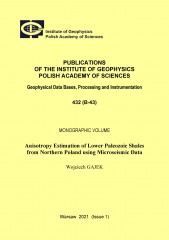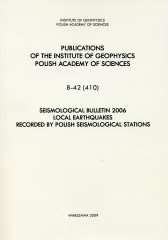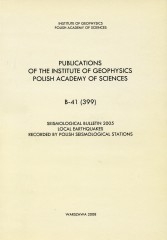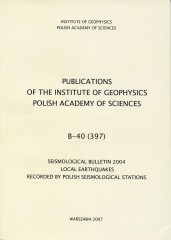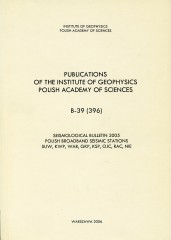BROWSE - VOLUME LIST
- A - Physics of the Earth's Interior
- B - Seismology
-
C - Geomagnetism
C-119, C-118, C-117, C-116, C-115, C-114, C-113, C-112, C-111, C-110, C-109, C-108, C-107, C-106, C-105, C-104, C-103, C-102, C-101, C-100, C-99, C-98, C-97, C-96, C-95, C-94, C-93, C-92, C-91, C-90, C-89, C-88, C-87, C-86, C-85, C-84, C-83, C-82, C-81, C-80, C-79, C-78, C-77, C-76, C-75, C-74, C-73, C-72, C-71, C-70, C-69, C-68, C-67, C-66, C-65, C-64, C-63, C-62, C-61, C-60, C-59, C-58, C-57, C-56, C-55, C-54, C-53, C-52, C-51, C-50, C-49, C-48, C-47, C-46, C-45, C-44, C-43, C-42, C-41, C-40, C-39, C-38, C-37, C-36, C-35, C-33, C-32, C-31, C-30, C-29, C-28, C-27, C-26, C-25, C-24, C-23, C-22, C-21, C-20, C-19, C-18, C-17, C-16, C-15, C-14, C-13, C-12, C-11, C-10, C-9, C-8, C-7, C-6, C-5, C-4, C-3, C-2, C-1
-
D - Physics of the Atmosphere
D-79, D-78, D-77, D-76, D-75, D-74, D-73, D-72, D-71, D-70, D-69, D-68, D-67, D-66, D-65, D-64, D-63, D-62, D-61, D-60, D-59, D-58, D-57, D-56, D-55, D-54, D-53, D-52, D-51, D-50, D-49, D-48, D-47, D-46, D-44, D-45, D-43, D-42, D-41, D-40, D-39, D-38, D-37, D-35, D-34, D-33, D-32, D-31, D-30, D-28, D-27, D-26, D-25, D-24, D-23, D-22, D-21, D-20, D-19, D-18, D-17, D-16, D-15, D-14, D-13, D-12, D-11, D-10, D-9, D-8, D-7, D-6, D-5, D-4, D-3, D-2, D-1
- E - Hydrology
- P - Polar Research
- M - Miscellanea
-
Online First
B - Seismology
Anisotropy Estimation of Lower Paleozoic Shales from Northern Poland using Microseismic Data
Author(s): Gajek W.
Volume: 432
Series: B-43
DOI: 10.25171/InstGeoph_PAS_Publs-2021-001
Volume: 432
Series: B-43
DOI: 10.25171/InstGeoph_PAS_Publs-2021-001
Downhole microseismic monitoring is a widely used tool for the assessment of hydraulic fracturing job effectiveness. During the process of fluid injection into the reservoir, new fractures develop due to the induced pressure, which gives rise to microseismic events. Therefore, the knowledge of an accurate velocity model is necessary in order to locate the induced micro-seismic events. Subsurface complexity is often raised by a horizontal layering, an intrinsic anisotropy of shales, and aligned fracture sets. That introduces anisotropic effects into the velocity field. In such a case, the anisotropy should be taken into account during the velocity model building. Otherwise, some errors will be introduced into the microseismic event locations, and hence, the interpretation of treatment effects will be biased. Therefore, this thesis is devoted to the anisotropy estimation using downhole microseismic data.
Seismological Bulletin 2006. Local Earthquakes Recorded by Polish Seismological Stations
Author(s): Guterch B.
Volume: 410
Series: B-42
Volume: 410
Series: B-42
The majority of seismic events recorded in Poland are caused by mining activity in the Upper Silesian Coal Basin and Lubin Copper Basin. Induced seismicity is observed less frequently in the Rybnik Coal District and Bełchatów Open-Pit Mining area. A tectonic event of magnitude M = 3.2 occurred on June 25, 2006, in Western Carpathians, about 12 km south of a series of local earthquakes recorded since November 30, 2004, until December, 2005, in the south margin of the intramontane Orawa-Nowy Targ Basin (Guterch 2006, 2008).
Seismological Bulletin 2005. Local Earthquakes Recorded by Polish Seismological Stations
Author(s): Guterch B.
Volume: 399
Series: B-41
Volume: 399
Series: B-41
The majority of seismic events recorded in Poland are caused by mining activity in the Upper Silesian Coal Basin and Lubin Copper Basin. Induced seismicity is observedless frequently in the Rybnik Coal District and Bełchatów Open-Pit Mining area. The series of local earthquakes that began on November 30, 2004, of local magnitude M = 4.4, macroseismic intensity Io = 7 in the southern margin of the intramontane Orawa-Nowy Targ Basin, Western Carpathians, have been still recorded in 2005, mainly in January and February (Guterch 2006, 2007). The strongest after shocks did not exceed macroseismic intensity 5 in the EMS scale.
Seismological Bulletin 2004. Local Earthquakes Recorded by Polish Seismological Stations
Author(s): Guterch B.
Volume: 397
Series: B-40
Volume: 397
Series: B-40
The majority of seismic events recorded in Poland are caused by mining activity in the Upper Silesian Coal Basin and Lubin Copper Basin. Induced seismicity is observed less frequently in the Rybnik Coal District and Bełchatów Open-Pit Mining area. The year 2004 was exceptional due to the occurrence of tectonic earthquakes, which even caused a slight, mainly non-structural damage to buildings. On November 30, 2004, an earthquake of local magnitude M = 4.4, macroseismic intensity Io = 7 in the EMS scale, followed by a long series of aftershocks occurred in the southern margin of the intramontane Orawa-Nowy Targ Basin, Western Carpathians (Guterch 2006). On September 21, 2004, earthquakes of local magnitudes M = 5.0, 5.3, and 4.3 were observed in the Sambia Peninsula, western part of the Kaliningrad enclave, Russia. Two strongest Kaliningrad earthquakes were widely felt in northeastern Poland. The Kaliningrad earthquakes are rare examples of intraplate earthquakes in the low-seismic area.
Seismological Bulletin 2005. Polish Broadband Seismic Stations SUW, KWP, WAR, GKP, KSP, OJC, RAC, NIE
Author(s): Jankowska W., Kowalski P., Zych A.
Volume: 396
Series: B-39
Volume: 396
Series: B-39
In 2005, the Polish Seismological Network of the Institute of Geophysics, Polish Academy of Sciences, consisted of eights sites. Of these sites, six were broadband, one long-and-short period, and the short period site at NIE. Following the nine actual activity reports of Polish broadband seismic stations, the report of 2005 covers all stations of the Polish Seismological Network (PLSN) in Poland. During 2005 the stations worked out without problems.


